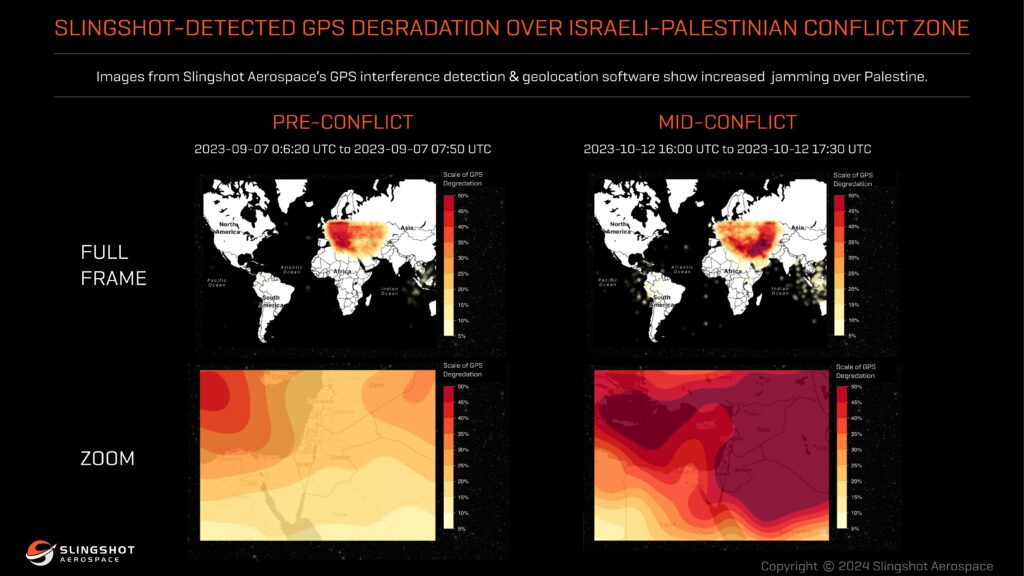EL SEGUNDO, CA, Jan 17, 2025 – Slingshot Aerospace, Inc. has announced that it has been awarded $1.9 million from the United States Space Force’s (USSF) Space Systems Command (SSC) to develop further Slingshot’s existing GPS jamming and spoofing detection, geolocate the sources and predict patterns of interference. Intentional GPS spoofing–a malicious technique that manipulates GPS data to skew an object’s geolocation–and GPS jamming are used across conflict zones to weaken combatant technology and often warn about future threats to national security.

The new program, PNT-SENTINEL (Positioning, Navigation, and Timing – Secure Electronic Navigation Threat Intelligence and Location), provides Slingshot with new funding to enhance its already operational technology by incorporating AI and predictive analytics to more rapidly disseminate insights to warfighters and support faster, more informed decision-making.
The PNT-SENTINEL contract was awarded as a Small Business Innovation Research (SBIR) Phase 2 contract by SpaceWERX, a space-focused division within the innovation arm of the U.S. Air Force, AFWERX. SSC awarded Slingshot a $1.9 million Phase 1 contract to develop its initial GPS jamming detection capability called DEEP (Data Exploitation and Enhanced Processing) in October 2021. The technology produced as a result of the DEEP contract provides the foundation for PNT-SENTINEL and is currently being used by the USSF to detect GPS jamming and ground-based interference sources related to ongoing conflicts, potential future conflict zones, and counterterrorism efforts.
“Modern military operations rely on space systems like GPS, so it’s no surprise that GPS jamming is already a pervasive threat,” said Tim Solms, chief executive officer, Slingshot Aerospace. “In addition to military operations, the larger global community is also highly reliant on GPS, but jamming and spoofing may not discriminate between military and civilian users – meaning that functions of daily life like financial transactions and commercial air traffic control could also be affected.”
Today’s global community relies more than ever on the signals from Global Navigation Satellite Systems (GNSS), which are satellite constellations that provide global PNT services. This includes the U.S. GPS system, the European Galileo system, and more. By interfering with those signals, bad actors can hamper satellite operations over a certain region. This interference also impacts ground- and air-based operations, including crewed aircraft, drones, and precision-guided munitions–and disrupts critical services for everything from troops on the ground to commercial airline operations and passenger vehicle navigation.
As part of the contract, Slingshot will leverage its recently announced AI model called Agatha, that helps identify anomalous spacecraft within large satellite constellations, to further explore, develop, and integrate cutting-edge AI into PNT-SENTINEL. By layering AI into Slingshot’s current technology, it will become more robust and automated in its ability to detect and flag jamming and spoofing threats, as well as differentiate between unintentional or anomalous interference and nefarious acts. Other enhancements to Slingshot’s capabilities include:
- Implementing pattern of life algorithms: Advanced patterns of life recognition will identify, flag, and evaluate active jamming events, predicting situation evolution.
- Multi-GNSS processing: Slingshot will expand beyond monitoring GPS interference and will detect jamming of multiple global navigation satellite systems by ingesting data from various sources, including allied nations’ spacecraft, for a comprehensive real-time view.
- Interoperable with existing warfighter systems: The capability will integrate with existing systems for real-time information dissemination, empowering warfighters to make timely decisions for strategic advantage.
- Enhancements to the user interface: An enhanced interface that will allow warfighters across the US and allied services in making informed decisions during security operations.
Slingshot’s GPS jamming and spoofing detection and geolocation capabilities leverage data passively collected by a mesh network of thousands of satellites canvasing the Earth. By collecting degradation signals from thousands of satellites that are constantly canvassing the globe, Slingshot is able to create a near-real-time picture of where GPS jamming is taking place on Earth at any given moment. Space-based technology offers broader jamming insight than existing ground-based detection systems. Legacy ground-based systems tend to have fixed receivers or limited distance receivers, that creates information gaps due to smaller coverage areas and limited deployment options in contested zones on land or at sea.
Source: Slingshot

